Takht Sri Damdama Sahib

Damdama means the breathing or resting place. Gurudwara Sri Damdama Sahib is one of the Five Takhts of the Sikhs. It is located at village Talwandi Sabo, 28 km southeast of Bathinda. It is also known as 'Guru Ki Kashi'. Guru Gobind Singh Ji stayed here after fighting battles against Mughal atrocities. Before his arrival at Talwandi, two of the Guru’s sons were bricked alive at Sarhind and two laid down their lives at Chamkaur Sahib. After writing Zafarnama, Guru Gobind Singh fought a successful battle at Muktsar and then moved towards Talwandi Sabo Ki. While at Talwandi, Sikhs started coming to the Guru from all over Punjab and other places. Here Takht Sri Damdama Sahib, Talwandi Sabo, Gurudwara Damdama Sahib, Damdama Tour a Gurudwara was erected in Guru's memory. This place is also known as Guru -Ki -Kanshi as it was made a center of the Sikh learning. Damdame Wali Bir of Sri Guru Granth Sahib was prepared here by Guru Gobind Singh. It was transcribed by Bhai Mani

